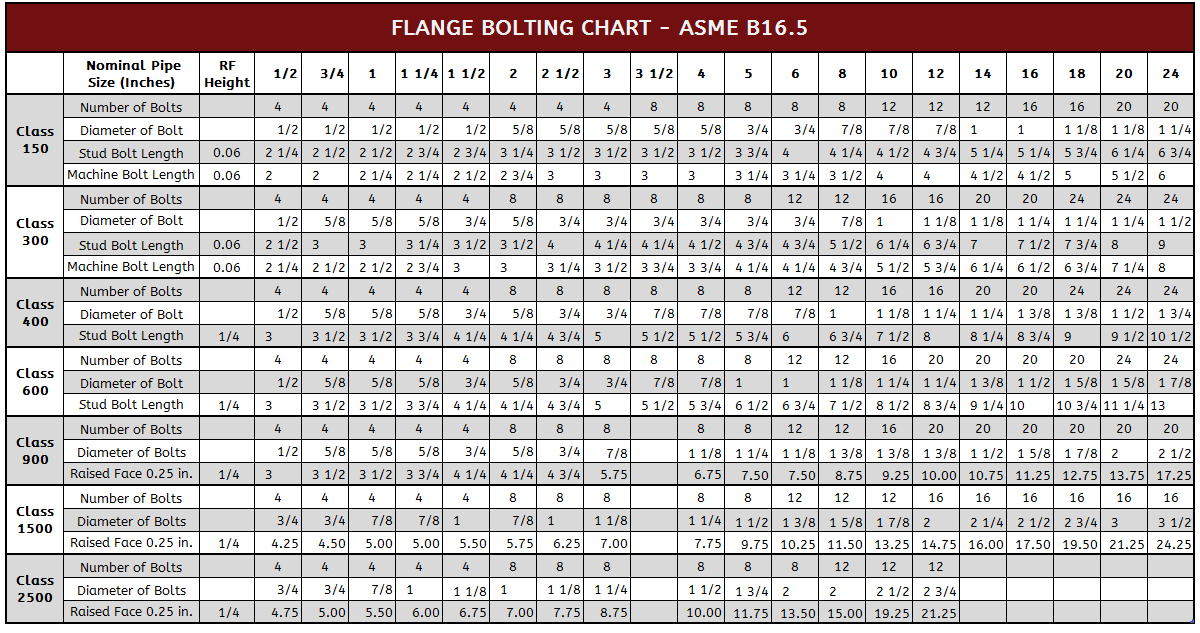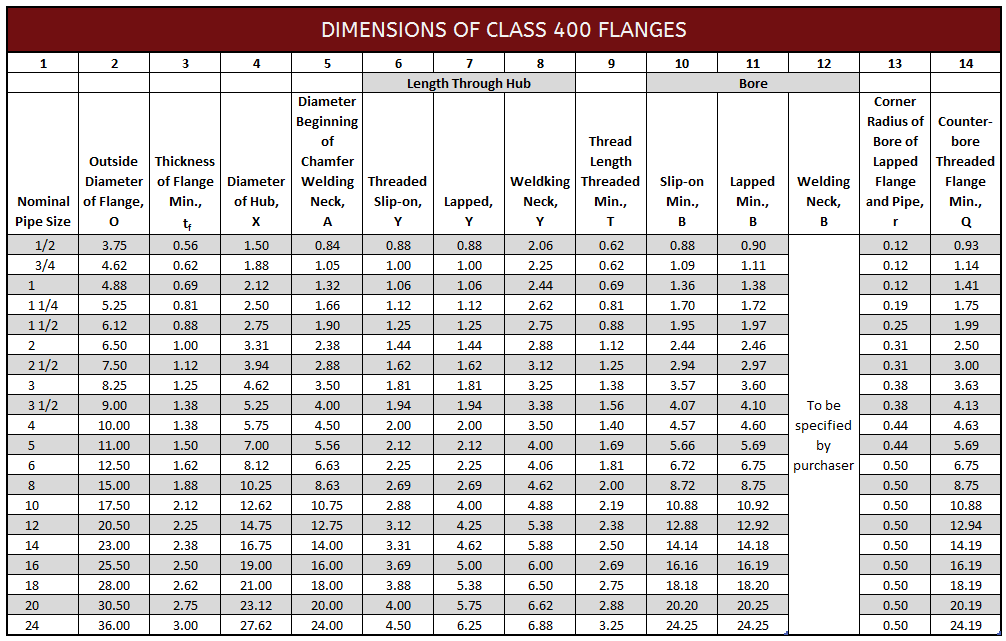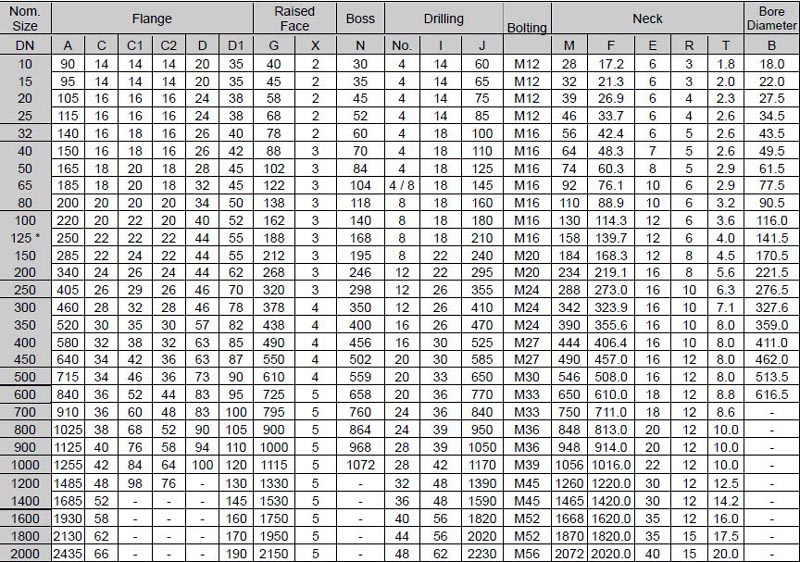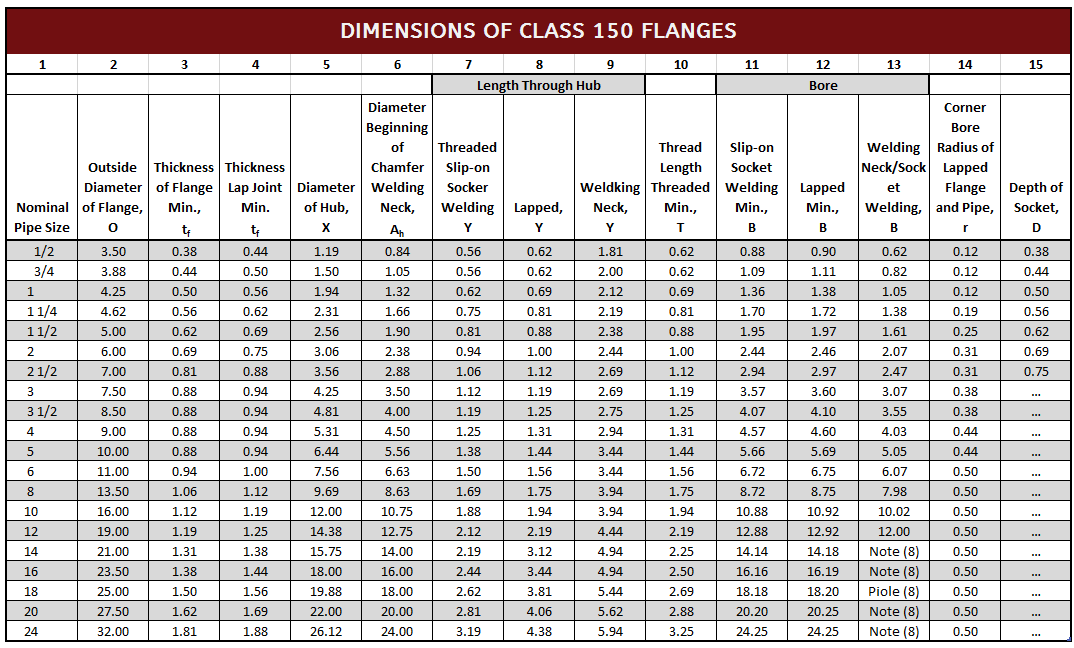Flange Size Guide Printable: Discover the ultimate tool for precise flange sizing. In this comprehensive guide, we’ll explore the importance of having a printable flange size guide, the different types of flanges and their sizes, and how to effectively use a printable guide for accurate measurements and calculations.
Whether you’re a professional in the industry or a DIY enthusiast, this guide will equip you with the knowledge and resources needed to navigate flange sizing with ease.
Introduction to Flange Size Guide Printable

Having a flange size guide printable is essential for anyone working with flanges in various industries. Flanges are used to connect pipes, valves, and other equipment, and ensuring the correct size is crucial for proper installation and functionality.
A printable guide for flange sizing provides a convenient and accessible resource for professionals and DIY enthusiasts alike. It allows users to easily determine the appropriate flange size based on their specific needs, saving time and effort in the process.
There are several benefits to using a printable guide for flange sizing. Firstly, it eliminates the need for manual calculations and measurements, which can be time-consuming and prone to errors. By simply referring to the guide, users can quickly find the correct flange size without the hassle of complex calculations.
Additionally, a printable guide provides a visual representation of different flange sizes, making it easier to understand and compare the options available. This visual aid can be particularly helpful for those who are new to working with flanges or need a quick reference.
Furthermore, a printable guide allows for portability and convenience. Users can easily print and carry the guide with them to job sites or keep it in their toolbox for easy access. This ensures that the necessary information is always at hand, regardless of the location or situation.
There are various situations where a flange size guide printable would be useful. For example, in construction projects, plumbers and pipefitters often encounter different flange sizes and need to quickly determine the correct one. By having a printable guide, they can easily identify the size and proceed with the installation process.
Similarly, maintenance and repair technicians may come across flange replacements where the size needs to be matched precisely. Having a printable guide allows them to quickly find the appropriate size, ensuring a proper fit and functionality.
Overall, a flange size guide printable is a valuable tool for anyone working with flanges. It simplifies the sizing process, provides visual aid, and offers convenience and portability. Whether in construction, maintenance, or DIY projects, having a printable guide can save time and effort, ensuring accurate and efficient flange installations.
Understanding Flange Sizing: Flange Size Guide Printable

Flange sizing is a crucial aspect in various industries, especially in engineering and construction. Flanges are used to connect pipes, valves, and other equipment in a piping system, ensuring a secure and leak-free connection. The correct flange size is essential to maintain the integrity and efficiency of the system.There
are different types of flanges, including weld neck, slip-on, socket weld, threaded, and blind flanges. Each type has its own unique design and purpose. Flanges are available in a wide range of sizes, from small diameters for residential applications to large sizes for industrial projects.Determining
the appropriate flange size involves considering several factors. These factors include the pipe size, pressure rating, temperature, material compatibility, and the specific requirements of the application. It is important to select a flange size that can handle the maximum pressure and temperature conditions of the system to ensure safe and efficient operation.
Types of Flanges and Their Sizes
There are various types of flanges, each designed for specific purposes. Here are some commonly used flange types and their respective sizes:
- Weld Neck Flange: This type of flange has a long neck and is designed to be butt-welded to the pipe. It provides excellent strength and is commonly used in high-pressure and high-temperature applications. Weld neck flanges are available in sizes ranging from 1/2 inch to 96 inches.
- Slip-On Flange: As the name suggests, slip-on flanges are easy to slip onto the pipe. They are commonly used in low-pressure applications. Slip-on flanges are available in sizes ranging from 1/2 inch to 60 inches.
- Socket Weld Flange: Socket weld flanges are designed to be welded to the pipe using socket welding techniques. They are used in small-diameter, high-pressure applications. Socket weld flanges are available in sizes ranging from 1/2 inch to 24 inches.
- Threaded Flange: Threaded flanges have internal threads that allow them to be screwed onto the pipe. They are used in low-pressure applications. Threaded flanges are available in sizes ranging from 1/2 inch to 48 inches.
- Blind Flange: Blind flanges are solid disks used to close off the end of a piping system. They are commonly used to terminate a pipeline or create a blind plate in a system. Blind flanges are available in sizes ranging from 1/2 inch to 96 inches.
Factors to Consider in Flange Sizing
When determining the appropriate flange size, several factors need to be considered:
- Pipe Size: The flange size should match the pipe size to ensure a proper fit and connection.
- Pressure Rating: The flange should have a pressure rating that is suitable for the maximum pressure of the system.
- Temperature: The flange material should be able to withstand the maximum temperature of the system without deformation or failure.
- Material Compatibility: The flange material should be compatible with the material of the pipe and other components in the system to prevent corrosion or chemical reactions.
- Application Requirements: Consider any specific requirements of the application, such as environmental conditions, industry standards, or regulatory compliance.
Flange sizing plays a critical role in the performance and safety of a piping system. By understanding the different types of flanges, their sizes, and the factors to consider in flange sizing, engineers and professionals can make informed decisions to ensure the proper functioning of the system.
Looking for something creative to do with the kids this Easter? Check out these easter coloring pages printable free . These printable coloring pages feature various Easter-themed designs that will keep the kids busy and entertained. From cute bunnies to decorated eggs, there’s something for everyone.
Simply print out the coloring pages and let the kids unleash their creativity with colors. It’s a great way to spend quality time together and create beautiful Easter-themed artwork. Grab your free printable coloring pages now!
Printable Flange Size Guide Templates

When it comes to finding the right flange size, having a printable guide can be incredibly helpful. Whether you’re a professional or a DIY enthusiast, these templates can assist you in determining the correct flange size for your project. In this section, we will provide a selection of printable flange size guide templates and discuss their features, layout, as well as the pros and cons of different template designs.
Template 1: Flange Size Chart
This template features a comprehensive chart that lists different flange sizes along with their corresponding dimensions. The chart includes information such as flange type, nominal size, outside diameter, bolt circle diameter, and number of bolt holes. The layout is clear and organized, making it easy to locate the desired flange size.
The pros of this template are its simplicity and ease of use. However, it may not provide detailed information on specific flange types or variations.
Template 2: Flange Size Calculator
This template offers a calculator-like layout where you can input specific parameters such as pipe size, flange type, and pressure rating. The template then generates the corresponding flange size based on the inputs provided. This interactive approach allows for more customization and accuracy.
The pros of this template are its flexibility and ability to cater to specific project requirements. However, it may require some basic knowledge of flange sizing and calculations.
Template 3: Flange Size Comparison
This template presents a side-by-side comparison of different flange sizes, highlighting their similarities and differences. It includes information on flange type, dimensions, material, and pressure rating. This template is particularly useful when comparing multiple flange options or when determining the suitability of a particular flange size for a specific application.
The pros of this template are its visual representation and ability to aid in decision-making. However, it may not provide detailed technical specifications for each flange size.
If you’re looking for a fun activity to keep the kids entertained this Easter, why not try an easter word search free printable ? This printable game is not only enjoyable, but it also helps improve vocabulary and spelling skills.
Simply print out the word search and let the kids find the hidden Easter-themed words. It’s a great way to celebrate the holiday and keep the little ones engaged. Get your free printable today and have a blast!
Template 4: Flange Size Reference Guide
This template provides a comprehensive reference guide that covers various flange types and their corresponding sizes. It includes detailed information on dimensions, material specifications, pressure ratings, and applicable standards. This template is ideal for professionals or individuals who require in-depth technical information.
The pros of this template are its thoroughness and accuracy. However, it may be overwhelming for those who only need basic flange size information.
Remember, when using these templates, it is important to cross-reference the information with reliable sources and consult with experts if needed. Each template has its own advantages and limitations, so choose the one that best suits your needs and preferences.
With these printable flange size guide templates, you can confidently select the right flange size for your project.
Tips for Designing a Custom Flange Size Guide Printable

Creating a custom flange size guide printable can offer several benefits to users. It allows for a personalized experience that meets specific requirements and preferences. Whether you are a professional engineer or a DIY enthusiast, designing your own guide can enhance accuracy and efficiency in flange sizing.
Here are some guidelines and recommendations to consider when creating a custom flange size guide printable:
1. Determine the Scope and Purpose
Before designing your guide, clearly define its scope and purpose. Identify the specific flange types and sizes you want to include. Consider the intended users and their level of expertise. This will help you tailor the guide accordingly and ensure it provides relevant information.
2. Organize Information Effectively
When designing your guide, it is essential to organize the information in a clear and logical manner. Use headings, subheadings, and bullet points to break down the content into easily digestible sections. This will make it easier for users to navigate and find the information they need.
3. Include Detailed Illustrations and Diagrams
Visual aids such as illustrations and diagrams can greatly enhance the usability of your flange size guide printable. Include detailed and accurate drawings of different flange types, highlighting the key dimensions and measurements. This will help users visualize the sizing process and ensure they choose the correct flange for their specific application.
4. Provide Step-by-Step Instructions
To make your guide more user-friendly, provide step-by-step instructions for measuring and selecting the appropriate flange size. Break down the process into clear and concise steps, and include any formulas or calculations that may be required. This will help users understand the sizing methodology and ensure accurate results.
5. Test and Refine the Guide
Once you have designed your custom flange size guide printable, it is important to test it for usability and accuracy. Have a few users with different levels of expertise try out the guide and provide feedback. Use this feedback to refine and improve the guide, making it as user-friendly and effective as possible.By
following these guidelines and recommendations, you can create a custom flange size guide printable that meets your specific needs and provides valuable assistance in the flange sizing process.
Frequently Asked Questions about Flange Sizing

Here are some commonly asked questions related to flange sizing:
What is flange sizing?
Flange sizing refers to the process of determining the appropriate dimensions and specifications for a flange, which is a component used to connect pipes, valves, and other equipment in a piping system.
Why is flange sizing important?
Proper flange sizing is crucial to ensure a secure and leak-free connection between different components in a piping system. It helps to maintain the integrity and efficiency of the system and prevent any potential issues or hazards.
What factors should be considered when sizing a flange?
When sizing a flange, several factors need to be taken into account, including the pipe size, pressure rating, material compatibility, temperature, and the type of fluid or gas being conveyed through the system.
How do I determine the appropriate flange size for my application?
To determine the appropriate flange size, you need to consider the pipe size and the corresponding flange dimensions specified in industry standards such as ASME B16.5 or ASME B16.47. These standards provide tables and formulas that can be used to calculate the flange dimensions based on the pipe size and other parameters.
Are there different types of flanges available?
Yes, there are several types of flanges available, including slip-on flanges, weld neck flanges, blind flanges, lap joint flanges, and threaded flanges. Each type has its own specific design and application.
Where can I find more information about flange sizing?, Flange size guide printable
For more detailed information about flange sizing, you can refer to industry standards such as ASME B16.5 and ASME B16.47. Additionally, engineering handbooks and online resources from reputable sources can provide valuable guidance and information on flange sizing.
